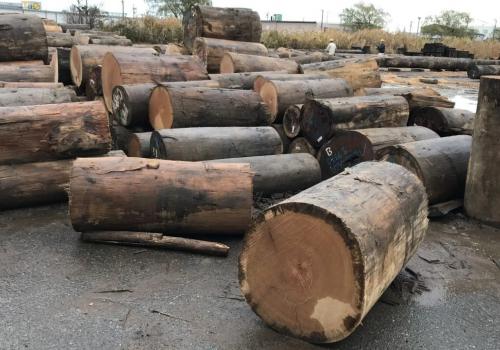Japan's biggest importer of logs from tropical rainforests will go out of business come spring, signaling that these imports may drop to nil sooner or later. "We considered ourselves the last 'goalkeeper' indispensable to our industry," said Yoshimasa Hirano, president of Daishin Plywood Industry Co. "But we lacked strength." Daishin Plywood in June announced that it would stop operating and go into liquidation in March. Based in the city of Niigata, on the Sea of Japan coast, Daishin was founded in 1957 and has since been processing imported tropical logs into plywood for walls and other applications. It handled 53% of all tropical log imports in 2019. Imported from Papua New Guinea, the logs piled in the back lot of Daishin's principal factory are from the company's last shipment; they will run out in late January, Hirano said. Daishin decided to pull the plug on its business in part due to an increase in plywood imports. But the decision goes deeper than that. In May 2018, the Malaysian state of Sabah, a major supplier of tropical logs, banned exports in the name of protecting forests. Daishin and other Japanese importers then turned to Papua New Guinea, which Japan now relies on for 80% of its tropical log imports.
But in February, Papua New Guinea raised export tariffs, citing the need for fostering its lumber industry, and is reportedly considering slapping an export ban on 50% of logs in 2025. "We will run out of breath if imports from Papua New Guinea come to a halt," Hirano said. In addition, the efficiency of plywood production has kept worsening as increased felling has narrowed the average diameter of logs to less than 60 centimeters from about 80 cm in 2000, reducing the rate of yield per log. Also, log prices are on the rise in Papua New Guinea, a trading house said. Prices on a delivery-on-arrival basis now stand at $200 per cu. meter, about $50, or 33%, higher than in 2019. Daishin has added new equipment in an attempt to become more efficient but remains unable to deal with the industry's deterioration. The impact of United Nations-set sustainable development goals on procurement has also "hurt us like a jab," Hirano said, noting that homebuilders and interior decorators have shifted to such wood products as medium-density fiberboard, which uses adhesives to mold domestic softwood and wood chips into panels. Japan used to be the world's biggest consumer of tropical logs, which it made into building materials and furniture. But by last year, imports had plunged to 134,000 cu. meters from a peak of 26.79 million cu. meters in 1973, according to the Japan Lumber Importers Association.
Japan still has companies that process tropical logs into plywood and other products. But they import so few logs that it is difficult for them to find ships willing to carry the difficult-to-transport cargo, a trading house executive said. "There is no denying that imports may drop to zero," the executive said. The country's plywood makers are increasingly using logs from cedar and other trees that grow in Japan. In 2019, 17.62 million cu. meters of domestic logs were used in the production of lumber and plywood, 1.5 times more than in 2002. Amid the industry tumult, Daishi decided to liquidate because doing so would be less risky than continuing operations, Hirano said. Japan has reached "a milestone for accelerating the shift to a circular economy from a development-oriented economy," said Atsuhiro Inoue, head of the Japan Plywood Manufacturers' Association. In the second half of the 1980s, Japan was bitterly criticized for destroying tropical rainforests. It took some 50% of the world's tropical broad-leaved log exports in 1987. It also accepted 10% of the world's lumber and 20% of its plywood exports, according to the Japanese government's 1990 environmental report. "The turning point came in 1992," Inoue said, noting the year that the U.N. Conference on Environment and Development in Rio de Janeiro, Brazil, adopted a declaration endorsing a basic concept of sustainable development. The Earth Summit also adopted a statement of principles for protecting forests. Japan's self-sufficiency in plywood came to 45% in 2019, up from 1% in 2000. Much of the increased use of domestic lumber can be credited to improved sawing technology. Different tree species have features that make them suitable for specific applications. But the needs of the times may be calling for domestic lumber, whose origins are clear.
